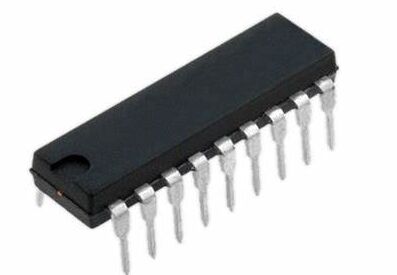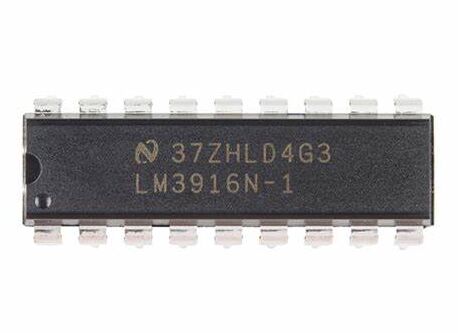By Texas Instruments 172
Ⅰ.Introduction to LM3914 VS LM3915 VS LM3916
•LM3914
LM3914 is an integrated circuit produced by International Rectifier. It is an analog integrated circuit used to build LED VU Meter. The chip is capable of converting the intensity of an input signal into the brightness of a set of LEDs to provide a visual representation of the intensity level of the input signal. This makes the
LM3914 widely used in audio equipment, audio measurement instruments, and other applications where signal strength needs to be displayed.
The LM3914 is a monolithic integrated circuit that senses analog voltage levels and drives 10 LEDs to provide a linear analog display. A single pin will change the display from a moving dot to a bar graph. The LED's current drive is adjustable and programmable, eliminating the need for resistors. This feature allows the entire system to operate at less than 3V.
The LM3914 is designed for versatility so controllers, visual alarms and extended scale functionality can be easily added to the display system. This circuit can drive multiple colors of LEDs or low-current incandescent lamps. Many LM3914s can be "chained" to form displays of 20 to more than 100 segments. Both ends of the voltage divider are available externally, so 2 drivers can be made into a zero-center meter.
LM3914 is very easy to apply to analog instrument circuits. A 1.2V full-scale meter requires only 1 resistor and a 3V to 15V power supply in addition to 10 display LEDs. If 1 resistor is a pot, it becomes the LED brightness control. A simplified block diagram illustrates this extremely simple external circuit.

•LM3915
LM3915 is a very commonly used level indicator IC. It is a linear voltage/current measurement IC in analog circuits and can be used to measure and display voltage or current levels. The LM3915 is widely used in audio equipment, power management, and other applications where voltage levels need to be monitored.
The LM3915 is a monolithic IC designed to sense analog voltage signals and produce incremental or sequential logic switches on its 10 outputs.
Indicating devices such as LEDs, LCDs or vacuum displays can be connected to these outputs to obtain corresponding visual indications in response to changing
input analog signals. The IC has a pinout that specifies whether the output LEDs are sequenced individually (dot mode) or in a bar graph format.

•LM3916
LM3916 is an integrated circuit specially designed for LED display. It is a linear voltage/current measurement IC in analog circuits and is usually used as a level indicator. Introduced by National Semicondutor (now Texas Instruments), it was designed to convert analog signals into LED displays.
The LM3916 is a monolithic integrated circuit used as a dot/bar display driver that is designed to sense various levels of analog voltage to operate 10 LED, LCD or vacuum fluorescent displays. The current flowing through these LEDs can be programmed and adjusted without the need for a current-limiting resistor in series with the LED. The LM3916 device requires a single power supply to operate the point driver display. This voltage ranges from a low value of 3V to a high value of 25V. The reference voltage used in the IC is easily adjustable.

Ⅱ.Features of LM3914 VS LM3915 VS LM3916
1.LM3914
•The internal 10-step voltage divider is floating and can reference a wider voltage range
•Drive LED, LCD or vacuum fluorescent lamps
•Display expandable to 100 steps
•Powered by a single power supply below 3V
•Internal reference voltage from 1.2V to 12V
•Outputs can interface with TTL or CMOS logic
•No muxing or interaction between outputs
•Output current programmable range from 2mA to 30mA
•Input can withstand ±35V without damage or false output
•Input ground operation
•User can select bar or dot display mode externally
2.LM3915
•The output is current regulated, open collector
•Users can adjust LED brightness and sensitivity via external resistors to meet specific application needs
•An internal reference voltage source is integrated to reduce the need for external components and simplify circuit design.
•Internal reference voltage range 1.2V to 12V
•Output current programmable range from 1mA to 30mA
•Display expandable to 90dB
•Able to provide linear level display with 10 LED outputs, each LED represents a level of the input signal
•Can operate under a single power supply voltage, simplifying the design of power circuits
3.LM3916
•Directly Drives TTL or CMOS
•Drivers LEDs, LCDs, or Vacuum Fluorescents
•Expandable to Displays of 70 dB
•Fast Responding Electronic VU Meter
•Outputs are Current Regulated, Open Collectors
•Internal Voltage Reference from 1.2V to 12V
•Bar or Dot Display Mode Externally Selectable by User
•Input Withstands ±35V without Damage or False Outputs
Ⅲ.Specification parameters of LM3914 VS LM3915 VS LM3916
1.LM3914
•Internal reference voltage: 1.25V
•Power supply voltage range: 3V~25V
•Current output range: 2mA~30mA
•Number of channels: 10
•Operating temperature range: 0℃~70℃
•LED current per channel (mA): 10
•Shutdown current (ISD)(type):2.4
•Package type:DIP and SOIC
2.LM3915
•Power supply voltage (V+): 3V~25V
•Power supply voltage (V-):0V
•Number of pins: 18
•Level range:0~V+
3.LM3916
•Output voltage (V):1.34V
•Input signal overvoltage (V): ±35V
•Line regulation (%V): 0.03V
•LED current (mA): 13
•LED current (mA):0.4-3.0
•LED current regulation (mA):0.25-3.0
•Standby power current (mA):9.2
•Saturation voltage (V):0.4
•Input signal overvoltage (V):±35
•Offset voltage, buffer and first comparator (mV):10
•Divider resistor (total pins 6-4): 8-17kΩ
•Output leakage current - point mode pins 10-18 (uA): 100
•Output leakage current one point mode pin 01 (uA): 450
•Standby power current (mA):9.2
Ⅳ.Working principle of LM3914 VS LM3915 VS LM3916
1.LM3914
Input voltage: The input to the LM3914 is a voltage signal, usually one related to the measured voltage or current.
Reference voltage: The user can set a reference voltage, which determines the level range displayed in the LED or other display element output by the LM3914. The user can adjust this reference voltage by connecting a potentiometer.
Internal comparators: LM3914 contains a set of comparators internally, which are related to the reference voltage. Each comparator is associated with one of the LM3914's output pins.
Display output: Based on the level of the input signal, the comparators in the LM3914 determine which output pins should be high, thereby enabling the corresponding LED. This forms an array that represents the level range of the input signal.
Segmentation: The LM3914 can be configured to enable specific outputs at specific levels. This configuration is usually accomplished by connecting the feedback pin. This allows the user to divide the measurement range into several sections, and each section can be represented by one or more LEDs.
2.LM3915
Input voltage: The input of the LM3915 is also a voltage signal, usually a signal related to the measured voltage or current.
Reference voltage: The user can set a reference voltage, which determines the level range displayed in the LED or other display elements output by the LM3915. Similar to the LM3914, the user can adjust this reference voltage by connecting a potentiometer.
Display output: Based on the level of the input signal, the comparators in the LM3915 determine which output pins should be high, thereby enabling the corresponding LED. This forms an array that represents the level range of the input signal.
Internal comparator: LM3915 also contains a set of comparators internally, which are related to the reference voltage. Each comparator is associated with one of the LM3915's output pins.
Segments and Sensitivity: The LM3915 introduces an additional feature where the user can set the number of segments and sensitivity displayed. By connecting external components, the user can adjust the LM3915 to display more or fewer segments, and the sensitivity between each segment can be adjusted.
3.LM3916
The LM3916 is a monolithic integrated circuit that can sense analog voltage levels (especially audio signals) and drive 10 LEDs in dot mode or bar graph mode. Its internal voltage divider is designed to have 10 levels, which actually corresponds to 10 LED or LCD displays.
The IC uses a high-impedance input buffer that can accept a 0-1.5V positive DC input signal, allowing the 10 comparators to operate with an overall accuracy of over 0.2dB. For a full-scale 1.2V meter, only one resistor is required in addition to the 10 LEDs. Using just one additional resistor makes it independent of the supply voltage, operating in the 1.2V to 12V range. The LM3916 can withstand voltages between +35V and a single potentiometer can adjust the brightness of the LED. Therefore, it is also the electronic form of the famous VU meter.
Ⅴ.The difference between LM3914 VS LM3915 VS LM3916
1.Level measurement range:
LM3914: 10 LED levels, suitable for linear level measurements.
LM3915: 3 LED levels, suitable for logarithmic level measurements.
LM3916: 10 LED levels, suitable for linear level measurement, but has some extra features compared to LM3914
2.Level control input:
LM3914: Level control via external voltage.
LM3915: Level control via external voltage or current.
LM3916: Level control via external voltage.
3.Level display:
LM3914: Provides linear level display, suitable for applications that require accurate display of different levels.
LM3915: Using logarithmic scale, it is more suitable for certain sound or audio applications, where logarithmic scale is more consistent with human auditory perception.
LM3916: Similar to LM3914, it provides linear level display.
4.Application fields:
LM3914: Usually used in applications that require linear level display, such as battery power display, etc.
LM3915: Suitable for audio applications such as audio equalizer.
LM3916: For applications requiring linear level display and has some additional features such as programmable reference voltage, etc.
5.Reverse level display:
LM3914: Reverse level display is not supported.
LM3915: Supports reverse level display and can be used in different application scenarios.
LM3916: Does not support reverse level display.
Frequently Asked Questions
1.What is the typical application of the LM3914?
The LM3914 is often used in applications where there is a need to visually represent the level of an analog signal, such as audio level meters, battery charge indicators, or any other system where monitoring voltage levels is important.
2.What is the typical voltage range for the LM3914?
The LM3914 is designed to operate with a supply voltage (V+) in the range of 3V to 25V. The input voltage (VI) should be within this supply voltage range.
3.What is the pinout of the LM3915?
The LM3915 has a pinout similar to the LM3914, with connections for power supply (V+ and GND), input voltage (VI), reference voltage (REF), and outputs for driving the LEDs.
4.What is the purpose of the internal voltage reference (REF) pin in the LM3915?
The REF pin in the LM3915 allows the user to set a reference voltage against which the input signal is compared. This reference voltage determines the range and sensitivity of the LED display.
5.Can the LM3916 be used in dot mode?
Yes, similar to the LM3914 and LM3915, the LM3916 can be configured for dot mode, where only a single LED is illuminated at a time to represent the current linear signal level.
6.How many LEDs can the LM3916 drive?
Like the LM3914 and LM3915, the LM3916 can drive up to 10 LEDs in a bar graph display.